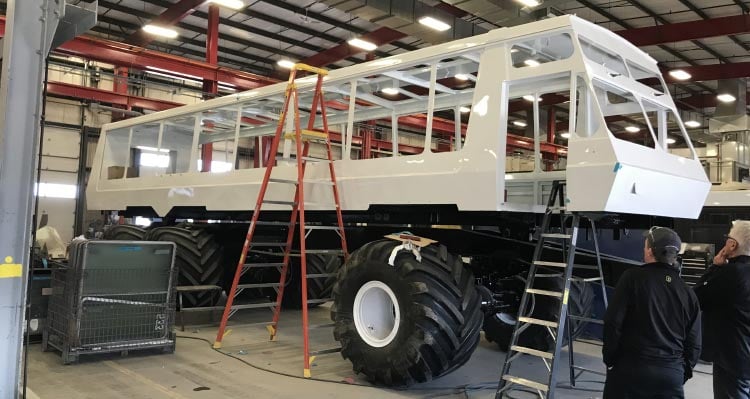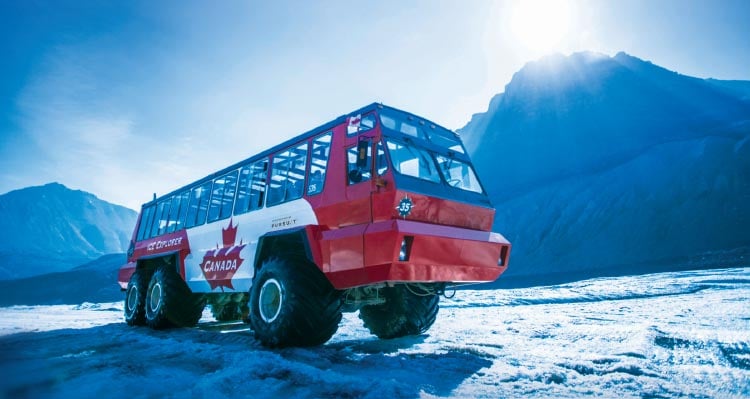In the Canadian Rockies, variations of “big” are a recurring theme. Towering mountains, vast forests, powerful waterfalls and never-ending rivers. And the same can be said for the Columbia Icefield, where expansive sheets of glacial ice dating back thousands of years straddle the British Columbia and Alberta border and hug the Continental Divide. It’s the largest mass of ice in the Rocky Mountains!
To experience the enormity of this colossal natural feature first-hand—and to navigate the terrain safely—you need proper training and gear. For those without it, the Columbia Icefield Adventure Ice Explorers are the best way to experience this once-in-a-lifetime opportunity.
Sean Wall, the Director of Operations at the Columbia Icefield Centre, describes these giant explorer machines as “highway coaches on steroids.” The 27-ton, six-wheel busses can carry up to 56 people. They’re specifically designed to go through non-traditional terrain—in this case, through a giant lateral moraine, across an ice core moraine and out onto the Athabasca Glacier.
Since the first Ice Explorer made its way up the Athabasca in 1951, big changes have been made to these machines in effort to lower the impact on the local environment. As of May, 2020, ten out of 22 Ice Explorers have seen a total refurbish, after having previously been maintained with standard upkeep for wear and tear on the machines.

“We went back to the basics and rebuilt the Ice Explorers down to the frame itself for a total overhaul, replacing the engine, transmission and working from the ground up,” Sean says.
Starting this July, even more changes are coming to the upgraded Ice Explorers. The next wave of improvements to the massive transport machines will house retrofitted next generation T4 engines—the same ones used in the newest highway transport trucks.
So how do all of these changes stack up? For starters, they've excelled at lowering emissions.
The original 6V71 engines used in the Ice Explorers would emit 10 or more grams of nitrogen oxide per kilowatt hour and 0.6 grams of particulate matter or fossil fuel emissions.
With the new machines, Sean says these emissions are reduced to .04 grams of nitrogen oxide per kilowatt hour and .02 grams of particulate matter—a 99.6% and 96.7% reduction, respectively. Adding that up over the six to eight trips a bus makes per day, and the emission reduction is significant. These reductions are possible thanks to the introduction of DEF, or diesel emissions fluid, technology—where an injection into the exhaust stream followed by a chemical reaction cleans the output air.
And the difference isn’t just in the numbers. The change to more eco-friendly engines has made a positive impact on the overall visitor experience as well. Bus drivers who double as tour guides shut off the engines once reaching the glacial destination, when it was previously encouraged not to do so.

This translates to a calmer experience for guests stepping foot on a glacier for the first time. With reduced background noise, the ability to take in the sounds and sensations of the unique natural environment is much more attuned and much more peaceful.
“The older engines needed to maintain a certain temperature to run effectively, so there was a risk in not running them constantly once up on the icefield,” Sean says. “With the new engines, they’re designed to run cooler and we’re now able to shut them off.”
In fact, Pursuit’s partnering power system company, Wajax Power Systems, has designed the buses so that their engines will automatically shut off after being immobile for 15 minutes. The Ice Explorers also have two shut off switches, meaning that the heat and auxiliary power can continue to run without the engine needing to be in power.
While two explorers are in line for the upgrade this summer, eventually the entire 22-bus fleet will implement the new improvements in a rolling cycle of engine changes.
We are building a team of passionate people determined to make a difference in the places we love. Every effort counts. Meet more of them here and discover how Promise to Place is the real deal.
Learn More
Insider tips, inspiration and deals — delivered straight to your inbox.